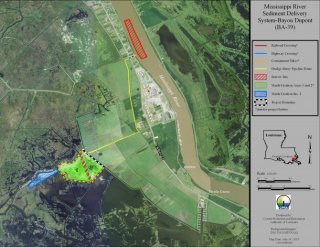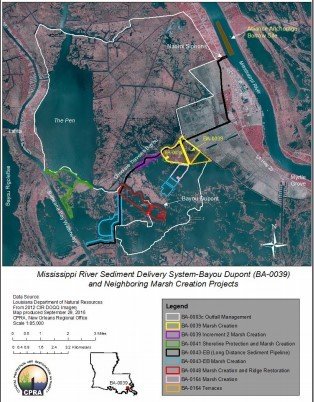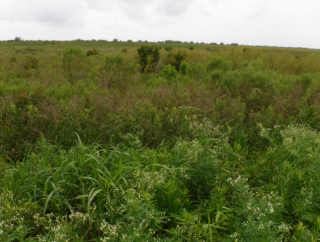Bayou Dupont CWPPRA Projects
EPA has sponsored two projects in the Bayou Dupont area of Plaquemines and Jefferson Parishes. The Mississippi River Sediment Delivery System-Bayou Dupont project (BA-39) was the first project under the Coastal Wetlands Planning, Protection and Restoration Act (CWPPRA) to use dredged sediment from the Mississippi River for marsh creation and to establish a reusable pipeline delivery system. The second project, Bayou Dupont Sediment Delivery - Marsh Creation and Terracing #3 (BA-164), was EPA’s first use of terraces in a restoration project.
The BA-39 project created 484 acres of marsh, and the BA-164 project created 144 acres of intertidal marsh and 9,679 linear feet of terraces. BA-39 pioneered a sediment delivery system using sediment dredged from the Mississippi River as a fill source and BA-164 continued the use of sustainable river sediment through this innovative delivery system. The Bayou Dupont project also successfully implemented the first use of overland pipeline transport of sediment from the River to build marsh using CWPPRA funds.
While using sediment from the Mississippi River now is commonplace, it was not a common restoration tool, nor widely accepted in 2003. In fact, most CWPPRA agencies felt that nothing would grow in Mississippi River sediment and costs would need to be included for plantings, perhaps on multiple occasions.
Project Area
The Bayou Dupont area consists of a rapidly eroding and subsiding portion of the Barataria landbridge.
The area suffers from a combination of negative influences, including a lack of natural fresh water, sediment, subsidence, and nearby dredging of oil and gas canals.
Hydrological modifications over time have led to increased salinities which then result in conversion to higher salinity marsh types and then conversion to open water.
Restoration
Project Design
The proximity of the project area to the River presented an opportunity to develop and implement a delivery system that carried sediment from the River to the project location. Unlike most marsh creation projects that involve using material from adjacent water bottoms, this project used renewable river sediment. This innovative feature minimized disruption of the adjacent water bodies and successfully restored the marsh platform.
Construction
As part of the project, a 95 linear foot, 48” diameter casing was left in place as a crossing under the New Orleans & Gulf Coast Railroad along with a 194 linear foot, 48” diameter casing under Highway 23 for future projects to use. Additional restoration projects continue to use these project features, facilitating the use of the renewable river sediment for restoration.
Benefits
The project area has completely revegetated on its own. The vegetation in some places is 5-7 feet high. The change from open water to marsh is dramatic.
Similar and synergistic projects include another CWPPRA project (BA-48), a State of Louisiana (BA-43EB) funded project, and a large-scale marsh restoration project currently under construction financed by the Deepwater Horizon Natural Resource Damage Assessment. These projects all use the river sediment and pipeline delivery concepts first implemented by the Bayou Dupont project and the conveyance route and infrastructure left in place.
Partners
EPA is proud to be the CWPPRA federal sponsor of the Bayou Dupont projects. We would like to thank our project partners, including the Louisiana Coastal Protection and Restoration Authority.
Learn more about CWPPRA and read the CWPPRA Fact Sheets:
- Mississippi River Sediment Delivery System-Bayou Dupont project (BA-39)
- Bayou Dupont Sediment Delivery - Marsh Creation and Terracing #3 (BA-164)
Learn about other EPA-Sponsored CWPPRA Projects.



